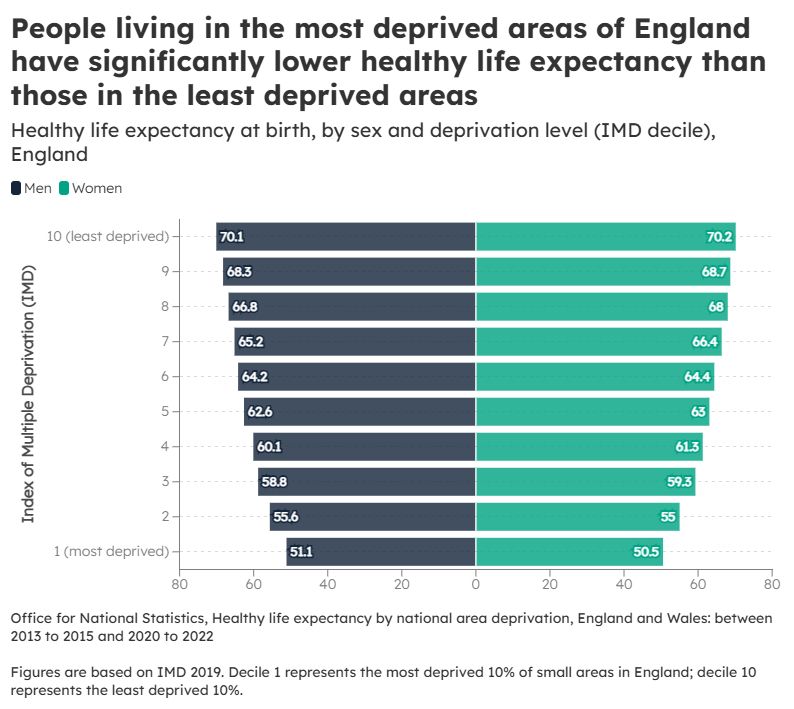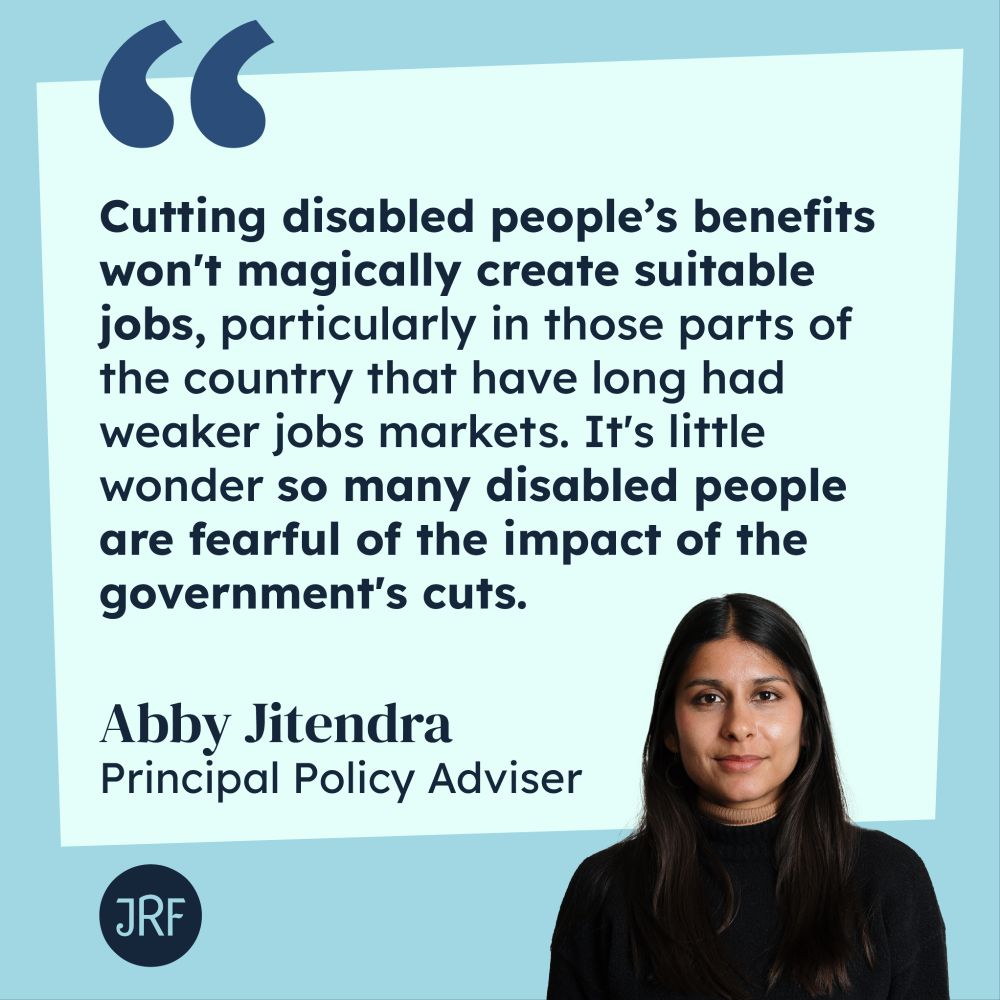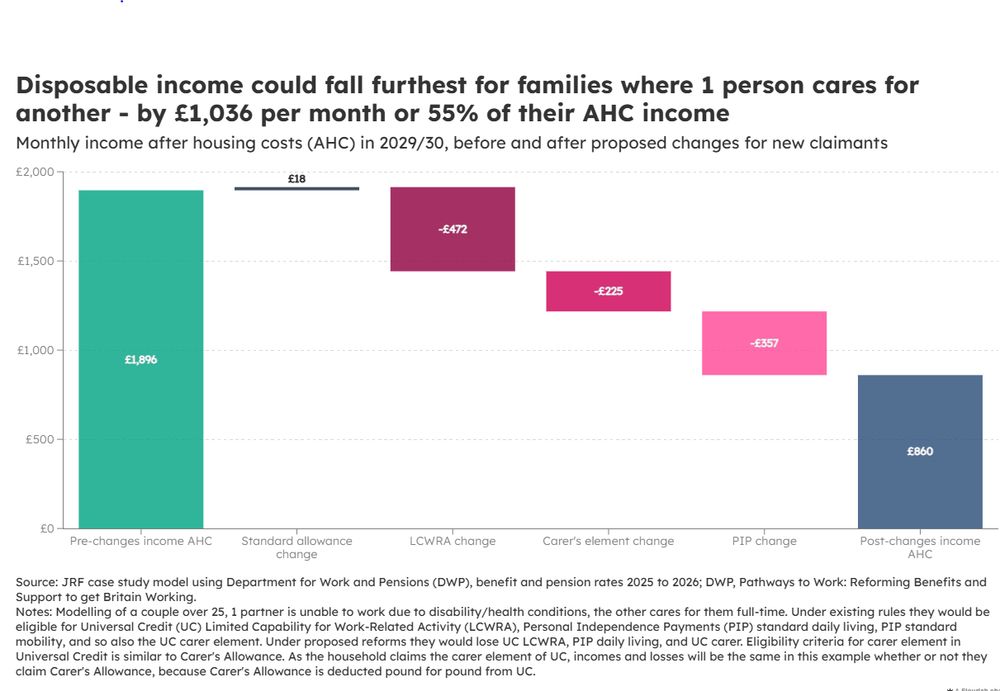Practical and progressive action here from the govt. Healthy workers benefit their companies and society overall. Right that employers are part of making that happen.
06.11.2025 09:22 — 👍 1 🔁 2 💬 0 📌 0
These measures would give social security a much needed boost, support the economy, and go a long way in protecting children's living standards
29.09.2025 10:28 — 👍 0 🔁 0 💬 0 📌 0

Improvements of this scale are urgently needed.
Families with children saw unprecedented reductions in their income last parliament and could do so again given the poor economic outlook
29.09.2025 10:28 — 👍 0 🔁 0 💬 1 📌 0
On its own, scrapping the two-child limit would lift around 300k children out of relative poverty.
But 140k kids are already impacted by the two-child limit and the benefit cap
So pairing up with a protected minimum floor would overall reduce child poverty by 500k in 2029/30
29.09.2025 10:28 — 👍 1 🔁 0 💬 2 📌 0
The average couple with kids is projected to lose £750 a year (1.3%) over the parliament. These two changes would reduce that by a third
Lone parent families would be even better supported. Rather than losing 3.0% of income (£780) they would instead be £320 a year better off
29.09.2025 10:28 — 👍 0 🔁 0 💬 1 📌 0

In new @jrf-uk.bsky.social analysis with @katieschmuecker.bsky.social we show how cost-effective improvements to social security can quickly improve the living standards outlook for families
Scrapping the two-child limit and creating an income floor in Universal Credit would make a real difference
29.09.2025 10:28 — 👍 1 🔁 1 💬 1 📌 2

A decade of falling incomes? JRF's pre-budget assessment of living standards
Average incomes are expected to fall by £550 over this parliament, meaning the Government risks having the worst living standards performance of any parliament on record.
But these projections can also be downgraded
As my colleague Chris Belfield has pointed out on the other place, lower productivity growth will make us poorer
For the full write-up of the analysis from Chris, @statspeter.bsky.social, and myself see the link below
www.jrf.org.uk/cost-of-livi...
27.09.2025 08:28 — 👍 0 🔁 0 💬 0 📌 0
Our estimates of living standards are based on the latest OBR and BoE projections for the economy. This data can and will change over the parliament as the economic and policy landscape changes
The more Government does now to improve incomes the better the outlook will be
27.09.2025 08:28 — 👍 0 🔁 0 💬 1 📌 0

Working-age households will fare worse than pensioners, driven in part by very different experiences of social security
Where over 65s will receive £270 more from social security, households headed by someone aged 35 - 64 will receive £150 less. For U35s the loss is £240
27.09.2025 08:28 — 👍 0 🔁 0 💬 1 📌 0

We project that the average real disposable income will be 1.3% (£550) lower in September 2029 than in 2024
Low-income households are set to lose the greatest proportion of their income - 2.7% lower than in 2024, leaving their income 6.2% (£1,110) lower than in 2019
27.09.2025 08:28 — 👍 0 🔁 0 💬 1 📌 0

Analysis from @jrf-uk.bsky.social this week suggests this could be the worst parliament for living standards since detailed records began
This doesn't have to be the case, but clearly more needs to be done to boost household incomes and ensure every family can afford the essentials
27.09.2025 08:28 — 👍 0 🔁 0 💬 1 📌 0
Delighted to give evidence to Work and Pensions Committee on pensioner poverty. Report says "retirement should be dignified and not a struggle at the poverty line." @jrf-uk.bsky.social and @crsp-uk.bsky.social's Minimum Income Standard measures this. What do the stats show? It's not good news (1/4).
24.07.2025 17:01 — 👍 31 🔁 15 💬 1 📌 2
Over 1.6m children are now impacted by the Two-Child Limit - 11.6% of all children
This is a cruel policy that unnecessarily drags children into deeper levels of hardship
It needs to go, and the longer it is kept, the greater the scarring effects on children's health and education will be
10.07.2025 10:45 — 👍 37 🔁 25 💬 0 📌 2

Bar chart titled "Healthy life expectancy at birth, by sex and deprivation level (IMD decile), England". The chart compares healthy life expectancy for men (dark blue bars) and women (light green bars) across ten deprivation deciles, from most deprived (Decile 1) to least deprived (Decile 10), based on the Index of Multiple Deprivation (IMD).
In Decile 1 (most deprived), healthy life expectancy is approximately 51.1 years for men and 50.5 years for women.
In Decile 10 (least deprived), it rises to about 70.1 years for men and 70.2 years for women.
The chart shows a clear upward trend in healthy life expectancy as deprivation decreases, with a nearly 20-year gap between the most and least deprived groups.
Source: Office for National Statistics (ONS), 2020–2022 data.
04.07.2025 11:06 — 👍 10 🔁 10 💬 2 📌 2
The Govt has not published an employment impact assessment for their disability benefit cuts & increased employment support
📣New @jrf-uk.bsky.social analysis shows where you live matters, with competition for jobs higher in some areas with higher claims: former industrial & coastal areas 1/5
24.06.2025 12:53 — 👍 26 🔁 18 💬 2 📌 3

"Cutting disabled people's benefits won't magically create suitable jobs, particularly in those parts of the country that have long had weaker jobs markets. It's little wonder so many disable people are fearful of the impact of the government's cuts" - Abby Jitendra, Principal Policy Adviser
Ahead of a crucial vote on cuts to disability benefits, our new evidence casts doubt on whether jobs are even available for disabled people facing cuts 📢
The analysis found that the parts of the country among the hardest hit by the cuts have fewer job opportunities 1/3
24.06.2025 08:29 — 👍 50 🔁 45 💬 4 📌 3
This analysis is one part of a forthcoming report from myself, @meriahlberg.bsky.social, and Fran Ladouch
That report makes the wider argument that these cuts are not the way to help disabled people into work, resulting instead in far greater hardship
24.06.2025 08:18 — 👍 15 🔁 2 💬 0 📌 0
Employers in more affluent areas of the country are more likely to encourage applications from disabled people, with 1 disability confident role for every 47 people on UC-Health
In ex-industrial areas this rises to 1 for every 333 people - a staggering gap that the cuts will do nothing to help
24.06.2025 08:18 — 👍 10 🔁 3 💬 1 📌 0

There is just 1 disability confident vacancy for every 121 people on UC-Health nationwide, this is clearly not enough
But the local disparities present for all job adverts are amplified for disability confident roles, with the greatest competition in some of the areas likely hardest hit by the cuts
24.06.2025 08:18 — 👍 9 🔁 3 💬 1 📌 0
This is not a perfect comparison. Not everyone has the skills or experience for every job and not everyone on UC-Health can work (although all are impacted by the cuts)
But we can ask how ready local employers are to hire and support disabled staff by looking at disability confident job adverts
24.06.2025 08:18 — 👍 11 🔁 3 💬 1 📌 0
Nationally, there is 1 job for every 7 people on Universal Credit searching for work or unable to because of a health condition
But this varies substantially by the strength of an area's economy. In ex-industrial areas there is twice as much competition among this group than the national average
24.06.2025 08:18 — 👍 12 🔁 3 💬 1 📌 0
The Government should cancel the cuts and rethink their approach
Because rather than help disabled people into work, if these reforms are implemented, they will likely be looked back upon as a disastrous method by which the Government will have impoverished the very people it aims to help into work
24.06.2025 08:18 — 👍 10 🔁 3 💬 1 📌 0

A graph showing that local authorities with weaker local economies have more people on UC that are searching for work or unable to work due to a health condition for each vacancy in that area
Much of the Government's intention for cutting PIP and UC is to motivate people to find a job
But cutting social security can't 'incentivise' people into jobs that don't exist
New @jrf-uk.bsky.social analysis shows there are simply too few jobs for the Government's argument to hold
24.06.2025 08:18 — 👍 74 🔁 38 💬 9 📌 6

Map showing proportion of working age population in receipt of health related social security, coloured by quintile of constituency. In some coastal areas, south Wales, the North West and Yorkshire and North East, rates are between 15-20%
Where will the cuts to sickness & disability benefits hit hardest?
New @jrf-uk.bsky.social constituency analysis shows the % of working age people receiving these benefits in England & Wales.
Some MP inboxes are likely to be brimming, as concern about these plans is widespread
02.04.2025 13:06 — 👍 29 🔁 33 💬 1 📌 7
This was raised in the Commons today. Heartening to see MPs across the House - many drawing on their lived experience - highlight deep concern over changes to PIP eligibility leading to loss of Carer's Allowance. parliamentlive.tv/event/index/...
27.03.2025 13:58 — 👍 8 🔁 3 💬 0 📌 0

NEW from @jrf-uk.bsky.social.
Much was made of the pressures from a “changing world” on public finances.
Those pressures are also impacting families, and government choices are making it worse.
We find the avg. family will now be £750/yr worse off by 2029, vs today.
Thread.
#SpringStatement
26.03.2025 18:33 — 👍 14 🔁 15 💬 1 📌 0

OBR's measure of living standards, RHDI, is up by £500 - largely due to stronger wage growth, including planning reforms which boost incomes.
BUT when you dig into it, 3/4 of the extra income from housing services is 'imputed rents' (what families would receive if they rented out their home).
1/3
26.03.2025 15:20 — 👍 18 🔁 10 💬 1 📌 1

Chart showing losses for a family where one person cares for another - monthly after housing costs income would be £1,036 per month less than the equivalent family now. That is 55% of their after housing costs income. In 2029/30 they would gain £12 from the higher basic rate of Universal Credit, but lose £472 from LCWRA change, lose £225 from the carers element change and lose £357 from PIP change.
Some families with a disabled adult stand to lose over £12,000 per year by 2029/30 as a result of the Government's disability benefit cuts.
Hardship being deepened by rebuilding the nations finances on the backs of disabled people
And polling suggests the public know it.
26.03.2025 08:09 — 👍 248 🔁 134 💬 9 📌 17
Official feed of the Social Mobility Commission. We monitor progress towards improving social mobility in the UK & promote social mobility in England.
https://linktr.ee/socialmobilitycommission
Policy @ JRF / Posts & views my own
analyst at @Joseph Rowntree Foundation
Posting about poverty, benefits and labour market in the UK.
Views my own.
Working at the Nuffield Foundation on Young People, Early Childhood, former CEO, Early Intervention Foundation. Views my own.
Professor of economics at UWE Bristol. Chair of Post-Keynesian Economics Society. Interested in macro, finance, banking, climate change, inequality, demographics.
https://people.uwe.ac.uk/Person/JoMichell
Work on campaigns and public affairs at JRF. Current home Bethnal Green, from Wycombe. West Ham ST holder. Views mine.
Developing advanced computational models to show how economic policy ideas might affect population health and inequalities across the UK. www.phiuk.org/policy-modelling-for-health
Policy thoughts: http://timleunig.substack.com Chief Economist Nesta, Director Econ PublicFirst, Vis Prof LSE Sch Public Policy, Vis Fellow Inst for Govt
British political correspondent at The Economist. Comment journalist of the year, British Journalism Awards 2023.
Head of Quant Research at Public First. Professional collector of other people's opinions
Principal Economist leading on trade and intergenerational fairness at the Resolution Foundation.
Secretary of State for Work and Pensions.
Labour MP for Wolverhampton South East.
Political Editor, The Guardian
https://www.theguardian.com/profile/pippacrerar
Unofficial bot account posting whenever the House of Commons Library publishes new research and analysis.
Policy and analysis correspondent, BBC Verify.
https://www.benchu.co.uk/
Author of "Exile Economics: What Happens if Globalisation Fails", published May 2025
https://linktr.ee/exileeconomics
the labour party's 2nd most important irish morgan?
I've written a book about the anti-brexit movement that will come out at some point and i co-edit @renewaljournal.bsky.social.
email me @ morgane.h.jones@gmail.com
Chief political commentator, The Independent, and visiting professor, the Strand Group, King's College London
Co-Founder of @britainelects.com
Journalist. Publisher of Wealth of Nations newsletter on Substack. Previously chief leader writer and columnist @TheTimes, chief Europe commentator @WSJ. Runner, cold water swimmer, aspiring chef.
https://nixons.substack.com/
Director of Research & Policy @IPPR.bsky.social and Professor of Social Policy, Policy Evaluation Research Unit, Manchester Metropolitan University. Economist: incomes, poverty, the labour market & microsimulation modelling















